

Revolution in a research environment
Exploring aliens with Runtime Revolution
No, neither the little green ones nor the men in black. By aliens here we mean non-native species introduced into new environments they did not belong to. Biological invasions of alien species are serious threat to ecosystems worldwide. Some alien species are noxious, act as parasites or vectors for new diseases, cause damage to environment or hit economies of nations. Others are endemic or protected elsewhere, or may have positive rather than negative effects, therefore the term "alien species" is not always a synonym for "pest". By definition alien species are always introduced by humans, deliberately or not. So this is not to be confused with natural range expansions, where species naturally arrive and settle in neighboring surroundings. Sometimes it is hard or even impossible to tell if species introduction is human-mediated or if it arrived by itself. In this case species is tagged "cryptogenic".
Video of a Revolution generated animation, showing spread of alien species
Probably the best known example is introduction of rabbits into Australia in the 18th century. This introduction had a devastating effects on local ecosystems killing and eliminating many native plant species and currently is suspected of being the most significant factor in species loss in Australia.
There are numerous cases from nearly any place of the Earth. For example appearance of ctenophore Mnemiopsis leidyi in the Black sea. A newcomer from the Atlantic coast of America, it did not have natural enemies in its new habitat and as it intensely preyed upon fish eggs and fry, its rapid spread caused a collapse of fishery in the region for a few years in late 1980s and early 1990s. However the arrival of one more alien ctenophore predator Beroe ovata, who luckily, devoured Mnemiopsis, brought new balance into the ecosystem and economies of the region.
The small crustacean water flea Cercopagis pengoi unintentionally introduced into the Baltic sea in late 1990s caused a similar collapse of gill net fishery by attaching to fishing nets in large quantities, kludging them and making them visible to fish. This phenomenon received a name of "nets plague". Later on, this tiny water flea became integrated into the foodwebs of local ecosystems and the problem of fish plague vanished in a few years.
Bivalvian mollusk Dreisenna polymorpha (native region is Ponto caspian) introduced into Great Lakes (the USA) caused great economic looses by blocking hydrotechnical facilities. Yet another well known alien, an infamous Atlantic shipworm Teredo navalis, whose early name Calamitas navis is quite self-explanatory. In Holland until 1730, dikes of earth and wood served as the country's sea defence. In 1730 an outbreak of what they called "pileworm" infested the wood pilings of their dike system. By 1731 the shipworm had destroyed 50 km of the Westfrisian dike system and had seriously weakened another 20 km. In 1731, when Teredo had eaten away wooden dyke gates, they crumbled in a huge storm and flooded the Netherlands. But that's not the end to journey of Teredo, 200 years later, 1919-1921, after its appearance in San-Francisco Bay (Pacific) it resulted in more than US$ 900 million damage to wooden piers and wharfs.
If interested, you can check a few factsheets on the regional NOBANIS project's website for more information.
To address the issue of invading species the European Commission launched a project "Delivering Alien Invasive Species Inventories for Europe" (DAISIE,) funded by the 6th framework programme. Around 300 scientists cooperated to collate all the available information on alien species introduced in Europe and the neighboring Mediterranean countries of Arabian peninsula and Northern Africa. The project successfully achieved what it was aimed at by collecting around 250 datasets covering 71 terrestrial and 5 marine regions. All the data was fed into a relational database. Currently it represents nearly 50 000 introduction events of 10 000 different species considered alien in Europe. More detailed overview of the database is available in a poster presented at the International Marine Data and Information Systems conference last year.
I was hired by the Coastal Research Institute for the work-package 3 of the DAISIE project whose aim was to create the database integrating all the data-sets submitted by partners. Runtime Revolution proved to be very efficient in handling large amounts of data and interfacing to databases. Therefore most of the tools used to transform and screen submitted data for possible errors as well as feed it into the database were implemented in Revolution. Besides, the database had to be extensively tested and for this purpose we wrote a software for data exploration "DAISIE explorer" for internal use within the project.

The application consists of five modules and a help system. Users can manually construct SQL queries and get the result using the direct SQL module (snapshot below) or use other modules to create the necessary SQL queries automatically and explore the database in user friendly environment.
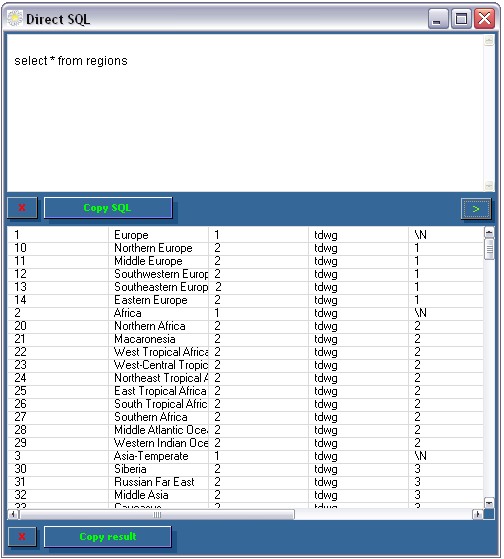

Species profiles - provides information on any selected species: its names including synonyms, taxonomy, native range, spread (countries and introduction dates) and impacts.

Country profiles - lists all the relevant data (species, introduction dates, impacts, etc...) for a chosen country.
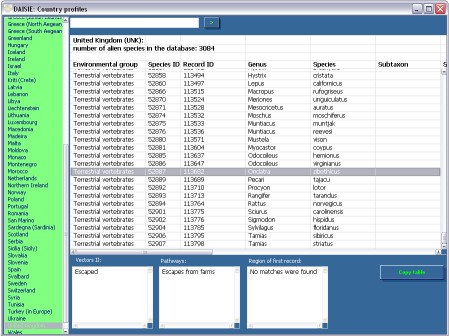
Count and Compare generates tables that compare different regions by various aspects of introductions. It actually just retrieves data from views created in the SQLite database.
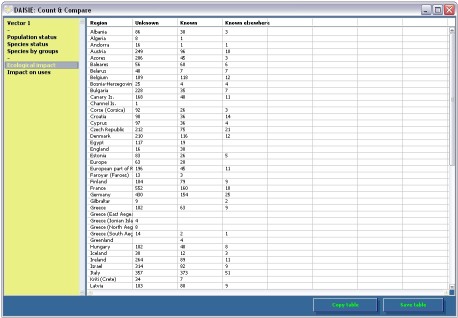
Map query module allows mapping of species spread or creating maps based on more detailed queries like selecting all countries where certain species belonging to certain genus was introduced between 1970s and 2000s. It works by turning on and off vector graphic areas representing countries, so there is nothing excessively complex in it.
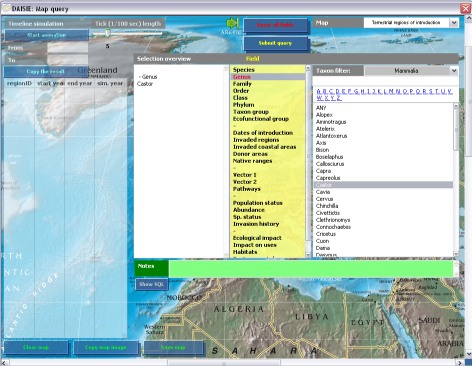
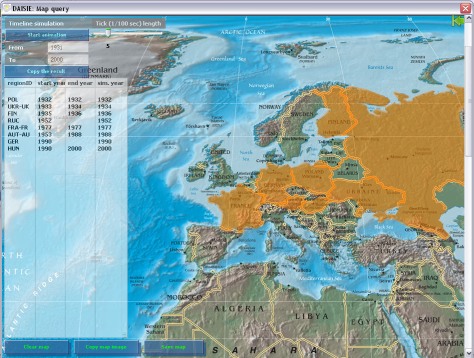
It also displays animated species spread maps like the one in a video at the start of this article.
I am continuing to use Revolution in my projects. I think it is a valuable tool for data processing, analysis, visualisation and doing various "stuff". It is something a researcher or analyst might wish to have always at hand.
 |
|




